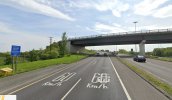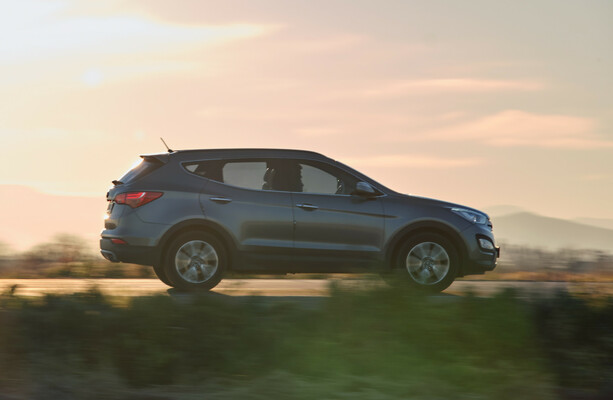Maybe I wasn't clear, I'm trying to understand how you took my reference to traffic travelling at an appropriate and safe speed and read that to assume that could only mean joining a motorway at the maximum permissible speed.I am impressed by posters who are able to differentiate between a question and a statement.
You are using an out of date browser. It may not display this or other websites correctly.
You should upgrade or use an alternative browser.
You should upgrade or use an alternative browser.
Bullying of small cars.
- Thread starter S class
- Start date
Agreed.There is no minimum speed limit on the M50.
Agreed. If they join the motorway at 70kmph while the traffic in the left lane is travelling at more then 70kmph then they are driving dangerously.A good driver can travel safely in the lefthand lane at 70kmph while the traffic in the other two lanes travel at 100kmph.
Not if they have just entered their lane right in front of them.Any good driver will be able to judge the speed of the car in their lane in front of them and indicate well in advance of catching up on it and then safely change lanes without reducing speed.
No, I'm describing a car moving with the flow of traffic which is then forced to slow by a dangerous driver entering their lane at a lower speed.What you are describing is a bad driver who speeds up behind the car in front. Then brakes and tailgates. It is then the action of this tailgating bad driver who creates the danger changing lanes, not the driver driving at 70 kmph.
I have.Drivers, including yourself should take an advanced driver course.
Road death statistics are measured by accidents per mile/Km travelled. Using that measure the M50 is the safest main road in Ireland. Using that same measure this is a far safer country to drive in than it was at any time in our motoring past and we are twice as safe as the USA.I don't doubt that you see plenty of these dangerous drivers on your M50 commute every day. The standard of driving on the M50 is appalling.
All traffic entering any motorway should use the slip road to accelerate up to the speed of the traffic already using the lane they are entering. That's what the slip road is for. It's one of the features that make motorways so safe.Are you suggesting that all traffic should enter the motorway at the maximum speed limit
RichInSpirit
Registered User
- Messages
- 1,210
Except for where the slip roads go uphill.
You have an example? They are usually designed to ensure that traffic has sufficient space to accelerate up to speed. I've never seen one that merits a grade warning sign but I certainly haven't seen them all.Except for where the slip roads go uphill.
When joining the M8 at jcn 3 southbound (Ballacolla) there is an initial uphill gradient. But, in my opinion, there's also a sufficient amount of level slip road lane to allow for the required speed to be built up.
That said I've only driven it in a moderately powerful car (150bhp)
That said I've only driven it in a moderately powerful car (150bhp)
thedaddyman
Registered User
- Messages
- 1,338
You have an example? They are usually designed to ensure that traffic has sufficient space to accelerate up to speed. I've never seen one that merits a grade warning sign but I certainly haven't seen them all.
When joining the M8 at jcn 3 southbound (Ballacolla) there is an initial uphill gradient. But, in my opinion, there's also a sufficient amount of level slip road lane to allow for the required speed to be built up.
That said I've only driven it in a moderately powerful car (150bhp)
I can think of at least 2 others on the M9, Castledermot (both north and south) and also the previous junction where the services are. Both have decent length slip roads and plenty of time and space to accellerate so being uphill shouldn't be an issue
One of the reasons the M8 drops to the N8 at Naas and further north, despite the road continuing to be a 3 lane dual carraige way is that the slip roads are not long enough to allow traffic to accelerate to potential motorway speed
All traffic?All traffic entering any motorway should use the slip road to accelerate up to the speed of the traffic already using the lane they are entering. That's what the slip road is for. It's one of the features that make motorways so safe.
Some traffic types have a lower speed limit than cars - what should HGVs and anything pulling a trailer do considering they shouldn't accelerate to 120kph or even 100kph (I realize many do).
Yes, of course vehicles shouldn't exceed the speed limit.All traffic?
Some traffic types have a lower speed limit than cars - what should HGVs and anything pulling a trailer do considering they shouldn't accelerate to 120kph or even 100kph (I realize many do).
Why are they almost always marked at slower speeds then? For example the slip leaving the M1 to the M50 is 60kmph?All traffic entering any motorway should use the slip road to accelerate up to the speed of the traffic already using the lane they are entering. That's what the slip road is for. It's one of the features that make motorways so safe.

There are plenty of examples of slip roads being lower speed than the road you came from AND the motorway, not just this one.
That's an exit, the context here is about being able to accelerate up to the speed of other traffic while joining the motorway.Why are they almost always marked at slower speeds then? For example the slip leaving the M1 to the M50 is 60kmph?
THE JOINT COMMITTEE on Environment and Climate Action is meeting this afternoon to discuss the impact on carbon budgets arising from the growing trend in car sales towards heavier and larger vehicles such as SUVs.... while Ireland’s taxation system for vehicles is emissions based, some countries base their motor taxes on vehicle weight.

 www.thejournal.ie
www.thejournal.ie

Poll: Should heavier cars pay more motor tax?
An Oireachtas Committee is meeting today to discuss the growing trend in car sales towards heavier and larger vehicles such as SUVs.
Flybytheseat
Registered User
- Messages
- 476
EVs would pay more taxation that dirty diesels if it was based on vehicle weight.THE JOINT COMMITTEE on Environment and Climate Action is meeting this afternoon to discuss the impact on carbon budgets arising from the growing trend in car sales towards heavier and larger vehicles such as SUVs.... while Ireland’s taxation system for vehicles is emissions based, some countries base their motor taxes on vehicle weight.

Poll: Should heavier cars pay more motor tax?
An Oireachtas Committee is meeting today to discuss the growing trend in car sales towards heavier and larger vehicles such as SUVs.www.thejournal.ie
The taxation should reflect the externalities of the vehicle in question. The diesel should have higher taxes due to the effect of pollution on people and the environment. Heavy EVs should have a higher tax based on the road wear/damage caused by their weight.EVs would pay more taxation that dirty diesels if it was based on vehicle weight.
Road wear isn't the issue with heavy EVs, the vast majority of usage related wear is born by the tyres and brake pads & discs. The challenge is the additional carbon/ pollution involved in their production and increased energy consumption in moving a heavier mass.Heavy EVs should have a higher tax based on the road wear/damage caused by their weight.
The tyres, discs, pads and electricity cost should already factor in their externalities through cost of complying with regulations or through taxes. Similarly, the original price of the vehicles should include the costs of these externalities.Road wear isn't the issue with heavy EVs, the vast majority of usage related wear is born by the tyres and brake pads & discs. The challenge is the additional carbon/ pollution involved in their production and increased energy consumption in moving a heavier mass.
Well, the price of every single thing you buy is influenced by the 'externalities' of regulations and taxes. I'm just not sure what point you're trying to make there, but let's ignore road wear as a factor on which to tax EVs, it's negligible.The tyres, discs, pads and electricity cost should already factor in their externalities through cost of complying with regulations or through taxes.
The pint in trying to make is that drivers aren't paying the full cost of their driving. They get away without paying for the costs of their pollution and this should be captured, possibly by taxation equal to the true costs.Well, the price of every single thing you buy is influenced by the 'externalities' of regulations and taxes. I'm just not sure what point you're trying to make there, but let's ignore road wear as a factor on which to tax EVs, it's negligible.
Of course they're not, that's not how most tax systems works. Consumption taxes usually don't come close to covering the costs of the service with the shortfall being made up from other sources of funding to the exchequer.The pint in trying to make is that drivers aren't paying the full cost of their driving. They get away without paying for the costs of their pollution and this should be captured, possibly by taxation equal to the true costs.
Adjustments to vehicle taxation is designed to influence consumer choice, it's not a cost play.
It's not supposed to be a cost play. By having the user pay the true costs, their behaviours would be changed, as their decisions would be based on the cost to society in general.Of course they're not, that's not how most tax systems works. Consumption taxes usually don't come close to covering the costs of the service with the shortfall being made up from other sources of funding to the exchequer.
Adjustments to vehicle taxation is designed to influence consumer choice, it's not a cost play.